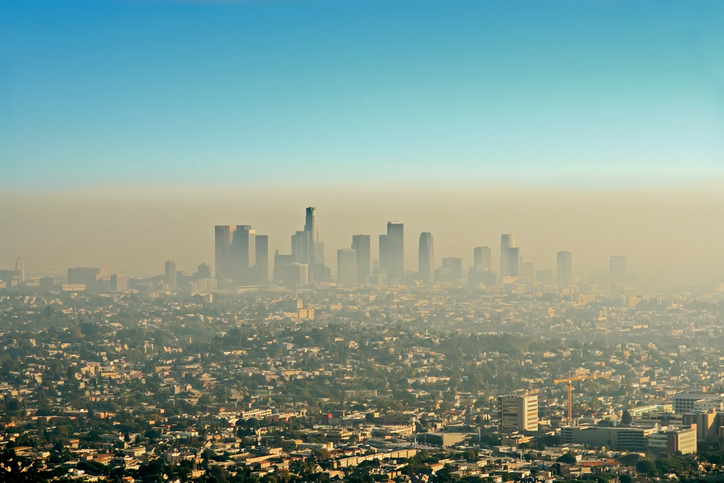Outdoor pollution is a public health concern around the globe. Recent data from the World Health Organization (WHO) further illustrates how our health is compromised when exposed to air pollution that has accumulated in high-enough concentrations:

- Outdoor air pollution has grown 8% globally in the past five years, with billions of people around the world now exposed to dangerous air.
- 92% of the world’s population lives in places where air quality levels exceed WHO limits.
- Three million deaths per year are related to exposure to outdoor air pollution.
- While all regions of the world are affected by air pollution, fast-growing cities in the Middle East, Southeast Asia, and the Western Pacific are the most impacted, with many showing pollution levels five to ten times above WHO-recommended levels.
According to On Call’s Chief Medical Officer, Dr. William Siegart, “The fact of the matter is simple: in order to stay healthy, we must breathe in clean air. We share these statistics not to scare travelers, but to inform them of the risks and the importance of preparing accordingly. Organizations not only have a duty to warn, but also a duty to inform—as such, I recommend sharing these actionable strategies with your travelers to help ensure they take the appropriate precautions when visiting areas affected by air pollution.”
- Learn About Your Destination: Air pollution concentration varies throughout the world, but it’s most prevalent in urban areas where smog, fine particle pollution, and toxic chemical pollutants concentrate. The greatest concern is regarding a form of pollution referred to as Particulate Matter 2.5 microns and smaller in size (PM-2.5), as these particles are small enough to be inhaled and deposited deep in the respiratory airways. The WHO reports a concentration greater than 10 micrograms per cubic meter of these fine particles in the air qualifies as dangerous and contributes to several health problems such as heart disease and severe asthma. The PM-2.5 microns are also responsible for reduced visibility and haze when the levels are high. This handy, three-dimensional world map makes it easier to gauge the depth of this problem in real-time as it shows anything less than 12 micrograms per cubic meter in blue and green and also notes the most highly polluted areas in dark red. Local pollution levels are also typically reported in newspapers, weather bulletins, and other credible media sources; however, it’s always best to round out any research and travel preparations with advice from a trusted health professional.
- Understand the Risks: Air pollution is not just a problem for the ill or individuals with pre-existing medical difficulties. It must be taken seriously by all people. Certain groups of people are especially sensitive. These groups include young children, the elderly, people who are active outdoors, and people with pre-existing heart or lung disease. Check with your doctor to ensure it’s safe for you to travel to a particular destination and determine whether you need a breathing mask, inhaler, or other medications. Depending on your doctor’s recommendations, a stress test and lung capacity test may also be good ideas.
- Make Informed Decisions: Some regions are much worse than others, and if a traveler is in a high risk category, it may be best to avoid travel to an affected area altogether. If travel is a must, staying indoors as much as possible is the best defense. Exposure can also be limited by engaging in outdoor activity at times other than peak hours (such as early in the morning) and avoiding outside activity on days when the ozone level is markedly elevated (many locations will provide air quality advisories in these instances). Very important to note: contrary to popular belief, cloth/surgical masks and bandanas are not effective, as they do not filter the small particulate matter. Instead, opt for a well-fitted N95 or N99 mask, which are both widely available for purchase online and also at home improvement/hardware stores (well- fitted means that there is no leaking around the edges). While these masks do not offer complete protection against particulate matter, they both offer substantial protection–95% and 99% respectively–against particles down to .3 microns in size (toxic particulate matter pollution is as small as 0.1 microns). Important to note: these masks are not effective against gases, vapors, or asbestos.
- Know the Symptoms (and How to Get Help): As noted above, there are several precautions travelers can take to avoid air pollution sickness altogether—however, it’s still important to recognize the warning signs and seek help at the onset. These signs and symptoms can range from irritations of the eyes, nose, and throat to respiratory distress, chest pain and other heart problems. Exposure can worsen all pre-existing pulmonary and cardiac disorders. Those with asthma or Chronic Obstructive Pulmonary Disease (COPD) will predictably experience a flare or worsening of their condition. In susceptible people, there is also an increased risk of heart attack and stroke. Long-term exposure to air pollution can cause cancer and damage to the immune, neurological, respiratory, cardiac, and reproductive systems. In severe cases, it can precipitate death. If individuals begin to feel seriously ill and/or experience symptoms while traveling, it’s important to seek medical care as soon as possible. On Call clients have access to emergency medical assistance services, 24 hours a day, 365 days a year.
Want more information regarding healthy travel and holistic travel risk management? Contact us today.


